Cinematography:
The scene begin’s with an arching wide-shot to show where the scene is taking place, what characters are involved, and establish the environment. It also show’s that Ofelia is alone in this moment. We then cut to a close-up of what’s in her book, signifying its importance, and the camera follows the images hat match up with the narration, creating a visual link between the story of fiction and the reality playing outer in front us. When Ofelia beings drawing on the wall, a close-up shows the shape that she is outlining, eluding to its significance later on in the scene, and also the effect that the chalk then has on the wall.
The camera cuts to the other side of the door to give the audience an un-obstructed view of the new environment. It also shows the scale of the hallway compared to Ofelia in a wide-shot. It also makes room for the contrast between the real and fantasy world, emphasising the nightmarish nature of the fantasy world. The wide-shot also shows how long the hallway is, which will be important as Ofelia fells from the pale-man, and also the alien architecture of the room.A close-up shows the hourglass and its importance, signifying that time may run out.
There is a wide-shot from over Ofelia’s shoulder to reveal the wide scale of the pale-mans room. The camera also stays near Ofelia to immerse us in her position, and make the audience feel like they are part of the scene. The camera crabs from left to right to follow Ofelia, keeping her centre frame and therefore the centre of the scene’s attention, but the camera is also placed on the other side of the table, allowing for us to seen all of the food placed on the table and her reaction to it.
This shot stops abruptly and rises to a slightly high-angle shot facing down at Ofelia. The stop makes the reveal of the pale man more surprising and shocking, and the camera pedestal makes him seem more imposing and also display the scale of the creature compared to Ofelia. It also rests for a moment on the pale-man to bring its horrific features to the audiences attention, allowing for them to become fearful of the monster, as they understand what it looks like.

After picking up the Petri dish, a close-up signifies that it is important, and an over-the-shoulder shot brings the lack of eye sockets on the pale man to our attention, making us question why there are eyes on the plate and where they fit into his character. A close-up of Ofelia shows that she is looking up, and so when we see the arching shot of the tapestries we, the audience, understand where they are in the room, and the camera movement shows all of the tapestries, showing the pale-mans history without audibly explaining it.
The low angle-shot of the shoes rises to make it seem like a very tall and intimidating pile, and the camera switches focus to show Ofelia’s reaction to the shoe’s. Letting the audience know that she is realising the danger of the situation. A wide-shot shows all the key-holes, and therefore establishes the risk of this moment. A close-up of the key signifies its importance, and a close-up of it being put into the lock raises suspense as we wonder whether it will work or not.
The camera is inside the hole as Ofelia reaches for the dagger, which makes us fear for what is inside the hole and how much danger she is in by putting her arm in there, and the silhouette in the bottom right corner makes us wonder what that is, increasing the tension of the moment. A close-up of the blade shows its importance.
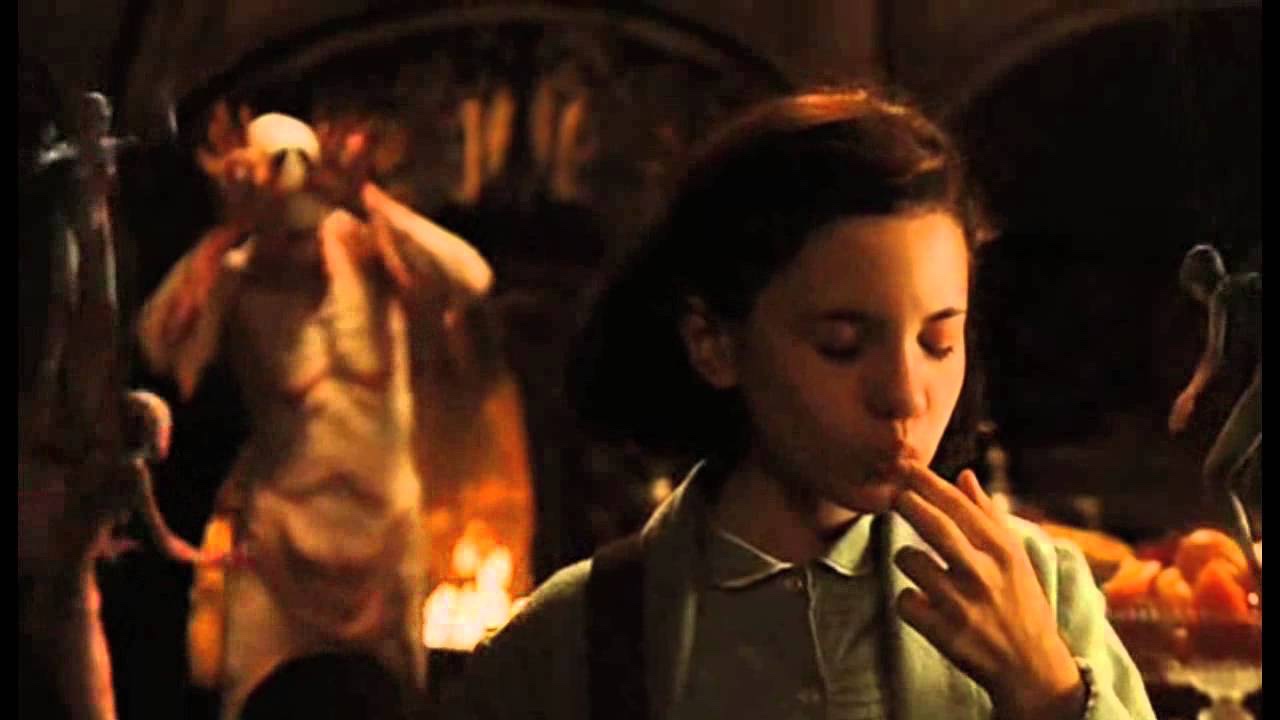
As Ofelia leaves, another shot lingers on the pale-man, since now we are wondering whether he will move or not. As she walks away, a close-up shows that she has come to a realisation, and the camera pans to the right to show what her attention has been caught by. A close-up of the grape brings to attention how enticing it is, and how delicious it looks. As Ofelia eats it the camera pedestals and pushes forwards, swapping focus to the pale-man to bring our attention to him and emphasise that he is about to do something, building suspense. The close-up of his hands shows the disgusting look of his fingers, and also pedestals up to show him coming to life and breathing for the first time. The next close-up shows his hands and him putting the eyes into them, answering the question posed by why the eyes were on a plate if he had no eye sockets.
The camera stays on Ofelia and keeps the pale-man out of focus to show that she is oblivious to him, and also raise tension as he approaches her. When Ofelia finally see’s him, the camera switches focus and remains eye-level with Ofelia to show how much taller and imposing he is compared to her, and install fear of the pale man in the audience. The closeup of the pale-man shows the gore when he devours the fairies, showing what he is capable of. As Ofelia turns and runs, the pale-man is kept in frame to show him wiping his mouth, and that he is ready to chase Ofelia.
The camera rapidly pans to the left to show that Ofelia is running back home, keeping her centre frame and therefore the centre of attention, and the fast movement of the camera creates tension and a frantic moment. The camera cuts back to the pale man to show that he is now in pursuit of Ofelia. The shaky camera used as she is running creates tension and reflects her panic. The shot of the other side of the wall slowly pushes out/dolly’s backwards, implying that there is no hope left. The pale-man is also shown entering the hallway and holding up his arm to let the audience know that he can see her, and is going to approach her.
As the pale-man walks down the hallway the camera follows his feet by quickly crabbing to the left, showing that he is heading towards Ofelia and also showing the speed with which he is moving, raising the tension of the scene. A close-up shows the chalk dropping, showing where it landed and how Ofelia can’t retrieve it, the chair legs wobbling, showing how close it is to toppling Oliver and therefore raising the risk and tension of the moment, and Ofelia’s horrified reaction to the pale man. The camera also quickly cuts back and forth between her and the pale man to emphasise how quickly he is catching up to her. When Ofelia climbs out of the doorway, there is a close-up of her hands on the floor to show how desperate and close to safety, and the camera quickly cuts between her feet and the pale mans closeness to them, raising tension and fear, keeping the audience on the edge of their seats. The doorway lets in light from the other room, emphasising the contrast between the two worlds and making the atmosphere and themes portrayed by the colour pallets more prevalent. There is also a close-up of the door to bring our attention to it shutting permanently.

Sound:
As the images come onto the page some fidgeting scribbling and scratching sounds can be heard, establishing a connection between the drawing and the magic of the moment, due to an invisible artist. The twinkle sound heard also adds to the fairy and fantasy themes/environment of the film. The non-diegetic narration shows Ofelia’s closeness to the story, and also shows the context for the images in the book. The non-diegetic composed score is subtle, with piano notes that adds a peaceful yet mysterious and somber atmosphere to the scene.
The chalk produces a sharp scraping sound on the wall, showing how rough and in-welcoming the architecture of the mill is, helping us understand Ofelia’s desire to escape. It also signifies the importance of the chalk in that moment, as important objects are the loudest in the diegetic sound score at their moment of significance. The later fizzing contrasts this, emphasising that the foaming and fizzing chalk is unnatural and adding to the fantasy element of the scene.
The music builds into a grand finish as Ofelia finally opens the door, signifying a change in environment and an important moment in the scene, keeping the audiences attention on the new world and building suspense as the door is slowly opened. The music here also signifies a grand entrance by Ofelia, showing her royal status in the fantasy world. The door also sounds extremely heavy as is it opened, showing Ofelia’s determination and obsession in the fantasy world. It also sounds like a boulder being pushed aside, adding a secretive and ancient feel to the new world.
As the camera shows the hallway, the music again builds into a trumpet filled climax, making the new environment feel un-welcoming and sinister. The distant diegetic sound of the pale man’s nasally and weak breathing makes the audience feel uncomfortable and concerned as Ofelia goes deeper into this fantasy world. This also establishes the pale-man’s power and dominion over the place, and eludes to a dark undertone to the new place.
The non-diegetic score regularly hits high notes that make the fantasy world feel more imposing and powerful. The diegetic sound of the chair wobbling also eludes to the later importance of it. A deep, fast sound of wind plays to make the environment feel cold and hostile, almost serving as a warning to Ofelia. Ofelia’s footsteps are quiet and isolated in the thick silence of the moment as she walks down the hallway, raising suspense as the audience anticipates a sudden rise in the sound mix or something to be revealed on screen. Otherwise the silence and unnerving ambient sounds like fire crackling and wind moving through the hall puts the audience on edge.
As Ofelia moves down the table and gets closer to the pale man the pitch and tempo of the breathing sounds increase, implying that they are coming from the pale man, making him more of an uncomfortable and intimidating presence, invoking fear of him in the audience. The composed score also reaches a sudden high as the pale man is revealed, making it more of a shock to the audience, creating fear of him in them, and also showing how invested Ofelia was in the food to the extent that she did not notice the pale man sat there.
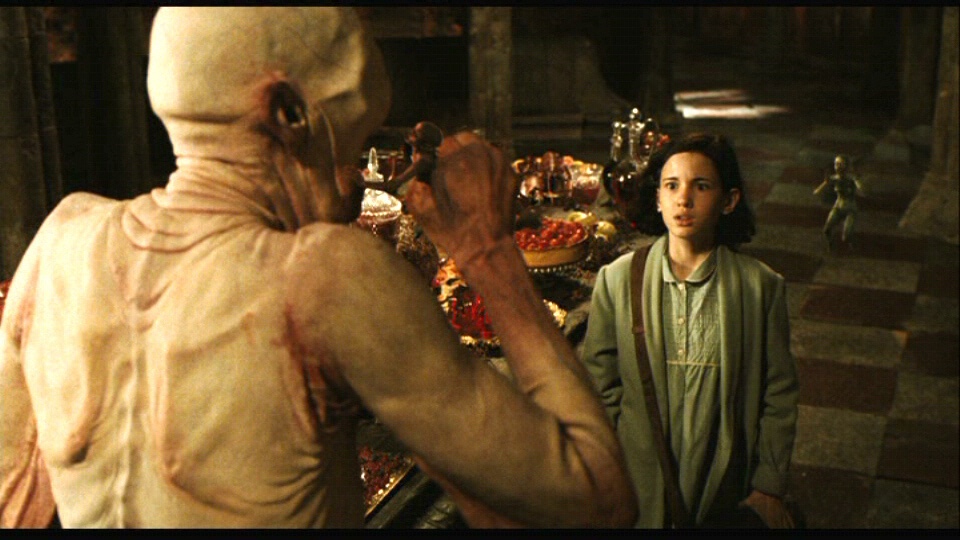
As Ofelia picks up the Petri dish with the eyes on, a wet squelching sound can’t be heard. This establishes the texture of the eyes, creating disgust in them and adding to the detail of the grotesque nature of the pale man. While Ofelia looks at the tapestries on the ceiling, the distant and faint sound of babies crying creates an audible link to the images on screen, signifying the violence and brutality of the pale man. As Ofelia brings out the key, a sharp ringing sound emerges in the diegetic sound mix, showing that it is an item of significance at this moment, and is about to play an important part in the scene.
The skittish and chirping diegetic sounds of the fairy’s movement signals to Ofelia and therefore the audience what they are trying to communicate, and their light and quick chirps convey emotions of happiness and a sense of victory, which quickly changes once the pale man wakes up, making the violence of the moment when he devours them all the more visceral and shocking to the audience.
The blade that Ofelia retrieves produces a sharp yet faint ringing sound, emphasising its importance to the plot, making it also more memorable once it becomes an important item in the film, much later on. As soon as Ofelia turns back to the pale man the non-diegetic composed score evolves into a deep and sinister toned moment, which creates feelings of tension and discomfort in the audience, as they, and Ofelia, are now expecting him to move, raising the tension of the scene.The non-diegetic sound of a harp also signifies and conveys Ofelia’s captivating by the fruit, showing why she has stopped and what has caught her attention, adding a heavenly and holy importance to the food on the table. The score also gradually picks up as Ofelia gets closer to eating the fruit, and this conveys to the audience that a direct and immediate consequence of this is about to occur, which we understand to be the pale man since the camera comes to focus on him.

As the pale man finally wakes up the non-diegetic score abruptly cuts off, making the moment more surprising and forcing the audience to keep complete attention on the pale man. The diegetic sounds of his movements are sudden, like bones cracking as they move for the first time in ages. His breathing too comes in long and deep and rough gasps, showing that this creature is ancient, and also making it seem more appealing and repulsive to the audience. This is also done by the sounds of his movements as he begins to walk, which are crooked and wet, which also increase in the sound mix as he gets closer to the camera, making the audience physically want to get further away from him.
We understand that the quick and frantic chirps from the fairy’s are intended to prevent Ofelia from eating the fruit, adding to the tension of the scene as we understand that they know about the pale man and the threat he poses. As the pale man moves his fingers, the string instruments in the composed score suddenly pick up, adding to the crooked and unnatural movements of the pale man with sudden and violent musical notes.
The non-diegetic composed and diegetic scores are layered, exampled by the manic chirping of the fairy’s and the building of the pitch of the intense and sinister music. This layering of sound makes the scene more intense and engaging for the audience.
Ofelia’s breathing deepens and accelerates, emphasising the fear that the pale man creates in her, and therefore the audience is left on edge too. The sounds of her footsteps as she sprints down the hall are rapid and heavy, showing her desperation to escape. When the pale man enters screen again and lifts up his arm a loud and screeching sound plays and temporarily dominates the diegetic sound mix, making the pale man a much more imposing and terrifying presence. We hear the diegetic sounds of his footsteps as he approaches Ofelia, increasing the tension off the scene. The chalk makes a faint but noticeable diegetic snapping sound, bringing the audiences attention to this and therefore establishing it as important. The diegetic sounds of the pale mans screeching sounds similar to a child in pain, naturally creating feelings of discomfort in the audience, making the creature more revolting and terrifying, and also adding tension, reminding the audience constantly that he is getting closer to Ofelia. The scraping sound of chalk on concrete is once again inserted to emphasise the importance of it as Ofelia draws one the ceiling. As Ofelia crawls into the real world, the close-up of her hands on the floorboard is accompanied by the diegetic sound of squeaking, which emphasises her desperateness to escape, and her closeness to safety and yet, danger. The same thing happens as the pale man thrusts his arms at Ofelia, showing his desperation in killing her. As the door shuts we also hear the diegetic sound of burning to show that it is shutting permanently.
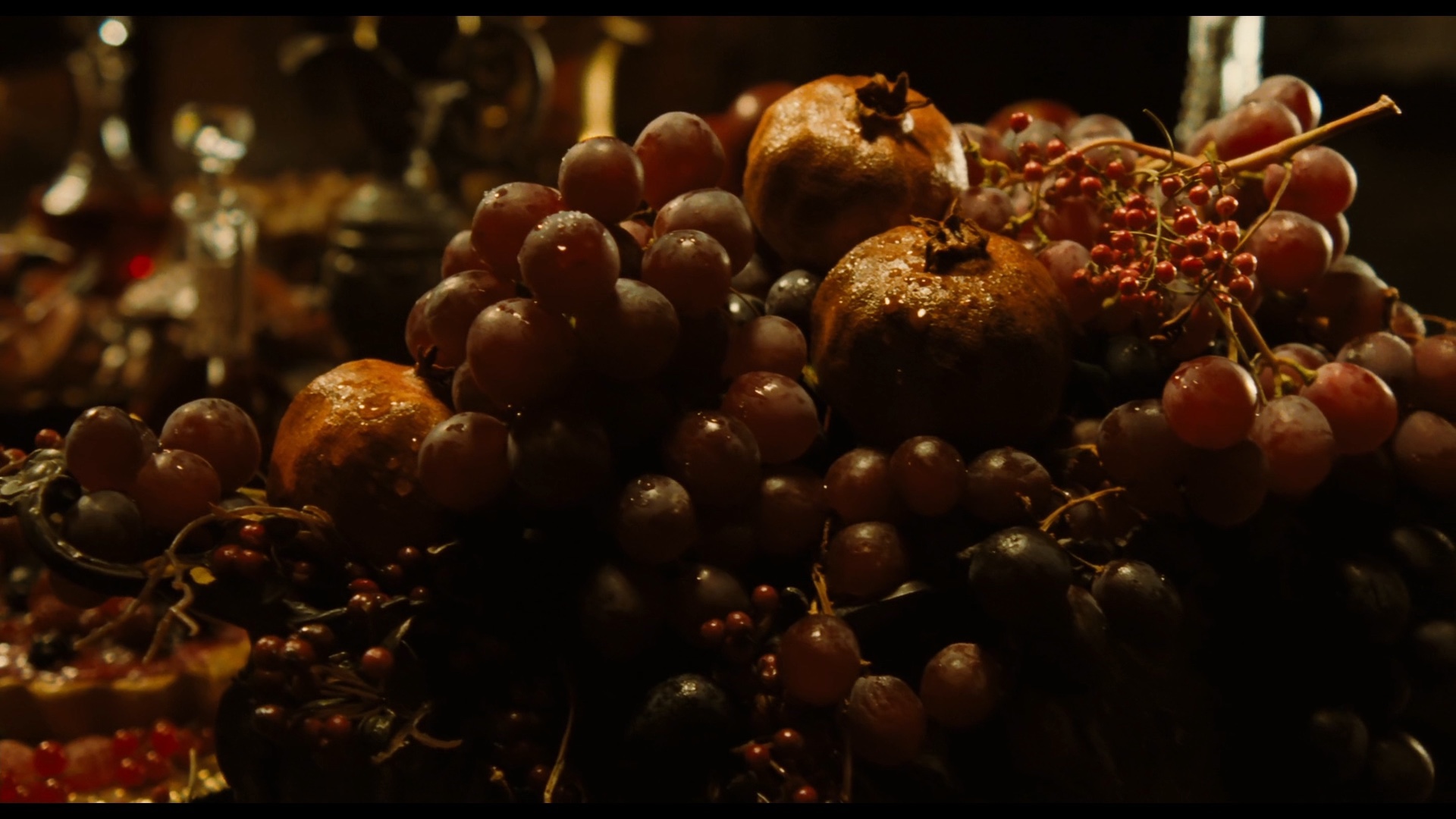
Editing:
The scene is kept at a slow pace by leaving shots long and in-interrupted, letting the audience, and Ofelia, take in the environment around them, and giving the scene appropriate time to raise suspense. As the camera dolly’s back down the hallway after Ofelia opens the door, the shot fades to a further away position, showing a passage of time and creating room without an unnecessary cut for us to view the hallway and new colour pallet. It also works better than a regular cut since Ofelia is still in the same place as in the previous shot, so a cut would be jarring as we, the audience, typically expect a change in shot after a cut, so a fade gives us more time to process this change in camera position.
We understand the scene with Ofelia opening the door and beginning to explore the pale man’s world to be continuity edited, as each shot takes place after the last. The scene changes to parallel editing though as the camera cuts back to the hourglass to remind the audience that time is running out. This is because we, the audience, understand that these two moments are taking place at the same time, and this serves the purpose of keeping in the audiences mind that time is running out for Ofelia, even when the hourglass is not on screen, raising the suspense of the scene and keeping the audience invested in the film as they know that things could go wrong for Ofelia at ant moment.
Post-filming, a red and hellish colouring has been added to the scene to make the environment seem. More intimidating and sinister. Every time an important objest is shown, it is done so via glance-object shots, signifying their importance as the camera keeps them as the only thing on screen. After releasing the fairies, the camera cuts back to Ofelia after holding focus on them for a moment, and she has moved, signifying a passage of time to avoid pointless scenes of the character walking around when the layout of this new world has already been established to us.
The scene cuts between Ofelia and her hand inside the hole to show that she does not know where her arm is reaching, what may be in the hole, and also her pained and struggling expression. As Ofelia leaves the room, her mental process is shown by moving the camera between her face and the fruit on the table, and the scene does not cut here so that we can see her turn her head and the camera move with it via panning to the left to show what she is looking at, and therefore what she is thinking about it.
As the pale man approaches Ofelia, the camera only cuts twice to slow the pace of the scene down and capture the audiences attention with the horror of the moment, and also raising suspense by making the moment feel longer by lack of edits. The scene begins to cut more rapidly between Ofelia and the pale man to show their proximity to each other, create tension in the scene and reflect the chaos and panic of the moment, immersing the audience in the process. There is more parallel editing when the camera cuts between the pale man and Ofelia to show that he is chasing her, making the scene more intense. A reaction shot shows Ofelia’s desperate reaction to the doorway shutting, emphasising how much worse the situation is becoming. The camera cuts rapidly between Ofelia on one side of the door and the pale man on the other, significantly increasing the tension of the moment. The scene finally stops cutting and rests on a wide-shot of Ofelia above the trapdoor after a close-up brings our attention to the door shutting, and this slows the pace of the scene and allows for the tension to dissipate.
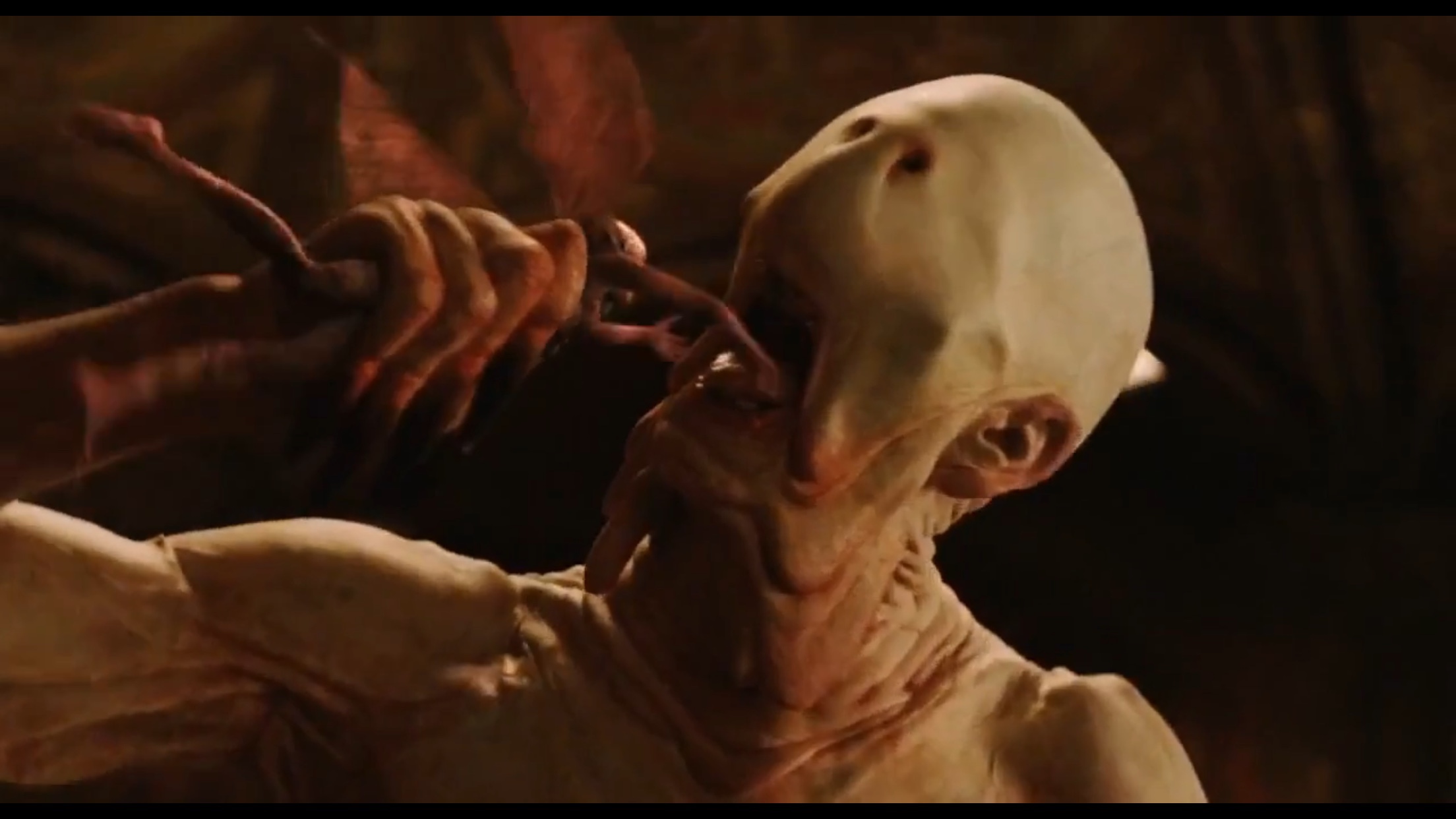
Mise-en-scen:
Ofelia’s outfit is similar to that of Anne Frank, which links to the time period of world war 2 and also emphasises the themes of suffering and hiding and imprisonment by Ofelia in the wake of ruthless of fascism. This also links to the pile of shoes shown later on, creating fascist symbolism in the pale man. The fairy tale drawings are similar to fairy tales of medieval Europe, contributing to Ofelia’s desire to escape the present to live in another world. The colour of the room she is in is blue and silvery, adding to the sharp contrast between it and the fantasy world. It also makes the room feel cold and still, and the old objects randomly scattered around the room establish how hidden and secluded it is, and why Ofelia chose to go here to complete the task set by the faun. The colour of the room also reflects the colour of the Captains uniform, symbolising his control over the real world.
The size of the doorway is quite small, making it seem more claustrophobic , and also references Alice in wonderland, in which the young protagonist takes a journey into a beautiful fantasy world through a portal, except here the horror is amplified by the supposedly idealistic world of Ofelia’s imagination being a nightmare in disguise.
The walls of the fantasy world seem to be coated in blood, which gives it a hellish and nightmare like quality. The hallway is filled with pillars that seem to resemble those one would expect to find in ancient cathedrals, which may be done to reference instances of child abuse or demonic religious imagery. The hourglass is a clear link to the theme of time in the movie, more specifically time running out. There also seems to be fingers clutching the hourglass, symbolising the pale man’s control over time in this world, or a tree’s branches, perhaps in reference to the tree in the film earlier.
The large fireplace behind the pale man creates hellish imagery, and references the Captains fireplace, inventing a link between the two characters and their control of wealth, and destruction of innocence, and tendency for violence. Ofelia’s costume her also makes her stand out, and signifies her innocence in a world built on top of death and suffering. The bountiful food on the table references fairy tales such as Hansel and Gretel, in which evil witches lure in innocent children via food. The food on the table also references Vidal, and also looks fake, as if imagined, filled with jellies and fruit. This is done to reference the colour red again, and therefore blood, and also to create an image of what a child of Ofelia’s age may imagine a feat to look like.
The pale man is sat at the head of the table with his arms layer out in front of him, showing his dominance over the room, and also referencing the Captains same place at his table, and his control over his world. The pale man’s body is revolting and deformed, humanoid yet alien, with sagging skin, red eyes, sharp fingers, and extremely pale skin, exposing the veins beneath. This creates feelings of repulsion in the audience, creating a disgusting and hideous creature that matches its actions of cruelty and violence, perhaps showing what Vidal looks like beneath his own skin. The pale mans sagging skin also shows that he has not eaten in a long time, and his previous fat has just come to hand off his body. The lack of eye sockets also removes all capacity for emotion. The blackened fingers also show corruption and greed. The eyes on the table also seem stuck to the petri dish due to a sort of disgusting slime attaching them both, adding to the disgust that the pale man’s physical from conveys.
The tapestries are shown to convey the pale man’s violent history without unneeded dialogue. The architecture also links to medieval catholic cathedral architecture, and they also show that the pale man may have a disturbing pride in his cruel history. The pile of shoes is an obvious link to the Holocaust and themes of child suffering and Fascism, also showing how deadly and ruthless the pale man is, and how many other people have tried, and failed, to defeat him.
The key that Ofelia holds is gold and crooked, showing its importance but also fantastical nature. The dagger, also, is gold and bright silver, with elegant engravings and a curved hilt that looks to the faun’s horns, which makes it seem like a beautiful and valuable weapon, fit for royalty. The grape that Ofelia notices as she leaves is large, plum-sized even! It also has water on it, making it seem enticing and delicious.
After devouring the fairies, the pale man has blood all over his mouth and dripping down his chest, making him seem even more ruthless and un-caring for the suffering he causes to others. His now visible legs are skinny, crooked and frail, showing his previous inactivity, and how his form is almost human, just not completely, almost as if it is trying to replicate a human. When Ofelia finally shuts the door, we see a bright light spilling out from underneath it, showing that the door is shutting.
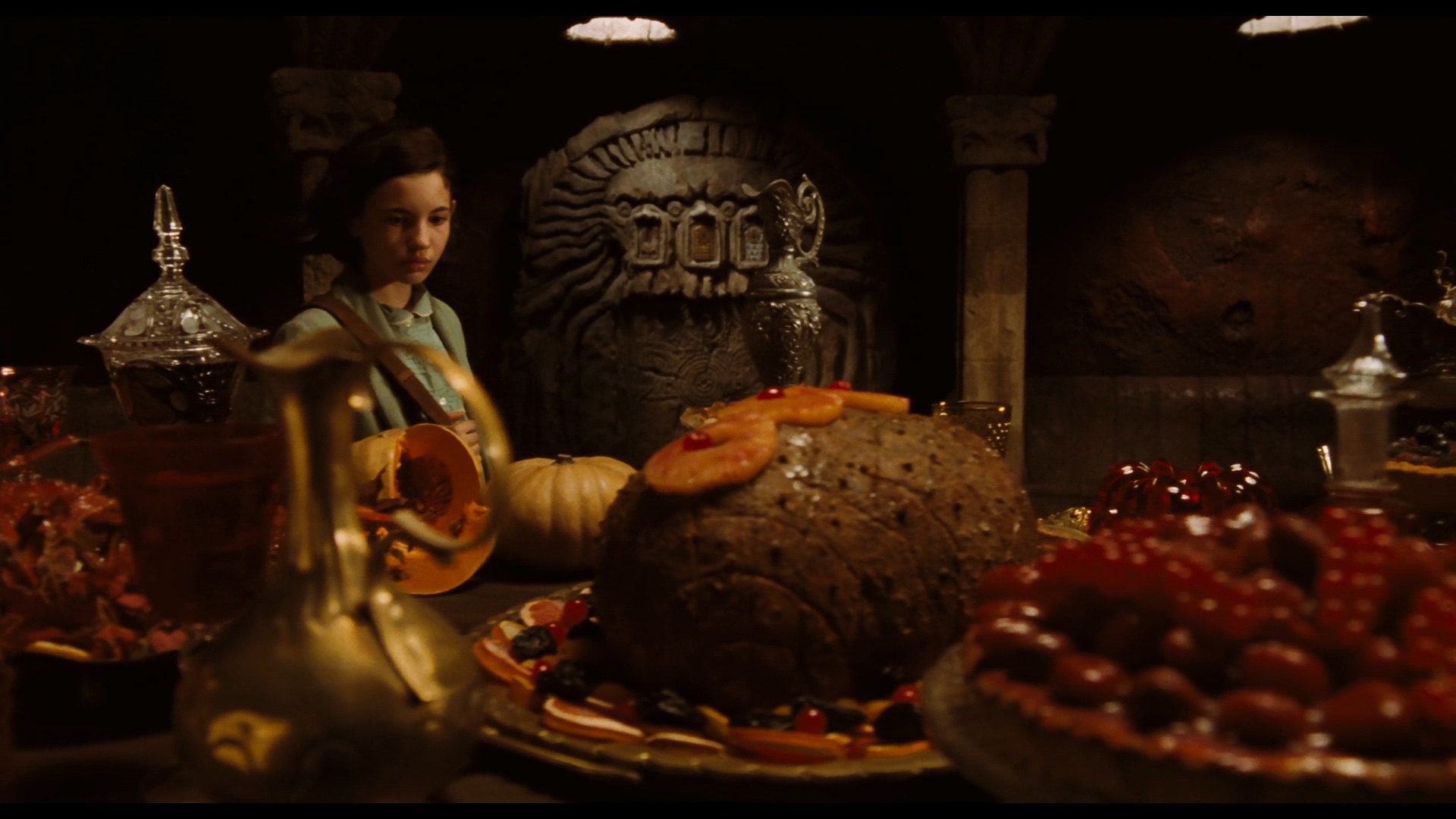
Performance:
As the drawings come onto the page, Ofelia seems completely immersed and fascinated in the drawings, showing her persistent child-like interest in magic and fairy tales. As the chalk begins to dissolve into the wall she seems surprised, showing that even she cannot predict how the magic will effect her world, yet she does not seem scared or apprehensive, signifying that she is not scared of the fantasy world, just eager to explore it. She also takes a good amount of time to study the hallway, showing that she is eager but not reckless in her exploration of the fantasy world. She takes her time as she walks about, which we, the audiences, knows to be foolish, as time is running out. This shows that she is mindful of danger but can be distracted by her obsession with the stunning and alien world in front of her, and become oblivious to her time limit in it.
She does not take her eyes off the food on the table as she walks down it, displaying her interest in it, and foreshadowing her later folly in being tempted by it. This also gives a reason for her to be shocked by the sudden appearance of the pale man. As with everything else not from the real world, Ofelia is absorbed by her curiosity in this foreign creature, yet still seems disgusted by its physical appearance. Her breathing gets more rapid and heavy as she looks around and notices the numerous signs of the pale-man’s danger, showing that she has caught on to the danger she may be in herself.
When she pulls out the key, Ofelia seems temporarily completely engulfed by her fascination in the item as she stares at it with a surprised expression for a few seconds. As she tries to retrieve the dagger from the hole, Ofelia briefly stands on her tip-toes to remind the audience that she is still small and vulnerable, and amplifies the risk and therefore suspense of the moment as we know that she cannot see what is in the hole. Her struggling expression shows that she is in possible danger, and is also not an invisible protagonist.

As Ofelia walks up to the pale man she seems nervous, letting the audience realise that she expects something to happen now, raising the suspense. When she tries to eat the grape she frustratedly swats the fairy’s away, and puts on an expression of pure joy and euphoria as she eats the grape, which show the audience the extent of her ignorance in this moment.
The movements of the pale man are sudden and crooked, his legs wobbling as he walks, showing how frail they are. His breathing is rough and laboured, showing his age, and his hands sake, showing his hunger and recent wake up from, presumably, a very long nap. Ofelia’s reaction to the pale man matches that of the audiences, disgusted and disturbed. Her breathing quickly becomes fast and heavy as she runs away, showing her panic, and her face and voice is terrified as she see’s the door closing, showing how desperate she is to escape. The pale man is clearly blind and reliant on his hands, as he recklessly stumbles about and holds his hands out before him to see where he is going.
After the chalk breaks, Ofelia looks back to see the pale man approaching her, and at his her face becomes pained and terrified, showing how much more serious and urgent the situation has become, making us, the audience, sympathise with Ofelia and also making the scene all the more intense and engaging. The pale man is also shown to be sadistic by the malicious grin on his bloody moth, showing his morbid pleasure in making others suffer.
As Ofelia finally escapes, we can see her face as she crawls desperately out of the hole, showing her eagerness to escape. As her legs are pulled out of the fantasy world we see a frustrated expression on the pale-man’s face and his arms frantically swinging to catch Ofelia, showing his desperate greed and hunger. When Ofelia shuts the door her breathing slowly slows to show that she has finally escaped danger, but suddenly picks up as the banging and screaming temporarily increases, establishing the fear that the pale man has created in her. But her panic evidently dissipates as the silence overcomes the screaming from the pale man.
You must be logged in to post a comment.